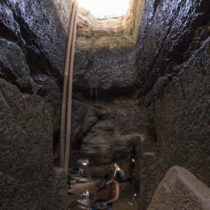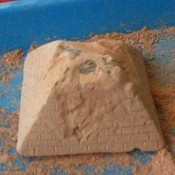The Swedish-Egyptian mission led by Dr. Maria Nilsson and John Ward (Lund University), found a New Kingdom sandstone workshop and several sculptures during excavations at Gebel el-Silsila archaeological site in Aswan.
Dr. Mostafa Waziri, Secretary General of the Supreme Council
of Antiquities, pointed out the discovery of a large ram-headed sphinx in the workshop area. The sphinx, approximately 5 m. long, 3.5 m. high, and 1.5 m.wide, finds a parallel to the ram-headed sphinxes of the area south of the Khonsu Temple at Karnak. A roughly-cut uraeus (coiled cobra) found embedded in the walls of the workshop was to crown the head of this large ram-headed sphinx.
The context allows archaeologists to date the finds back to the era of Pharaoh Amenhotep III of the 18th Dynasty.
Abdel Moneim Saeed (Director General of Aswan and Nubia Antiquities) said that researchers also unearthed hundreds of fragments from a Naos of Amenhotep III (Naos E), all inscribed in hieroglyphs. They also found other fragments associated with the sculpture of a falcon. In addition, archaeologists retrieved parts of an obelisk, including its pyramidion, and a blank round-top stela.
Nilsson said that during excavations, the team also discovered a smaller piece, of another ram-headed sphinx; probably the work of an
apprentice.
The sculptures are roughly cut and had been prepared for transportation. They likely abandoned at Gebel el-Silsila as the larger sphinx broke. Since then, later Roman quarrying activity buried the sphinxes into the soil.





